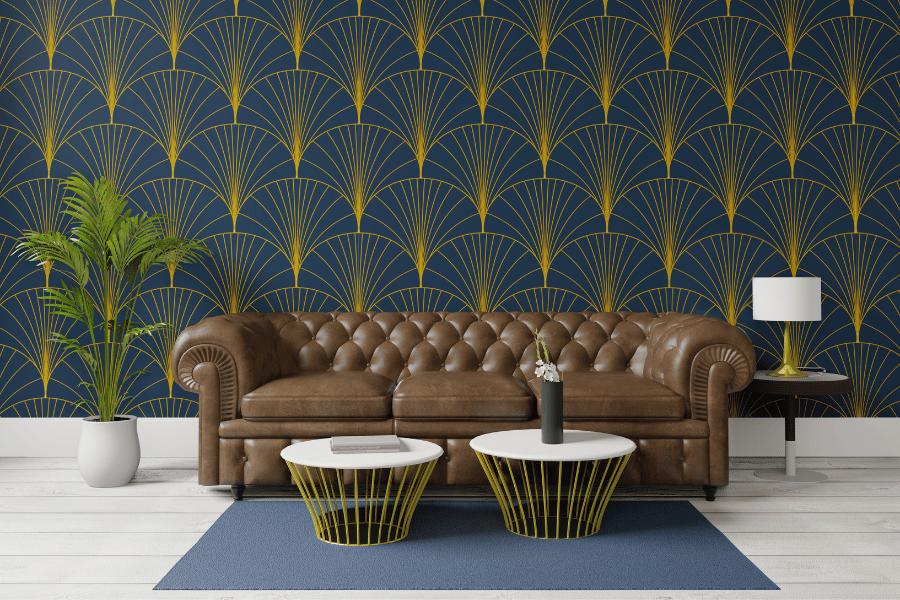When it’s time to update your space, one of the quickest ways to refresh a room is by adding a new coat of paint. But what happens when your walls are covered in wallpaper? While the idea of stripping wallpaper can be daunting, the good news is that you don’t always have to remove it.
Painting over wallpaper can be a great option, as long as you take the right steps. In this guide, we’ll share tips and tricks to help you successfully paint over wallpaper and achieve a smooth, professional finish.

Why Paint Over Wallpaper?
There are several reasons why painting over wallpaper might be a better option than removing it. If your wallpaper is in good condition and adhered tightly to the wall, removing it could cause unnecessary damage to the drywall underneath.
In other cases, stripping wallpaper can be time-consuming and labor-intensive. By painting over it, you save time and effort while still giving your space a fresh, updated look.
Before You Start: Inspect the Wallpaper
Before diving into your painting project, it’s important to assess the condition of the wallpaper. Not all wallpaper is suitable for painting over, so check for the following:
Tight Adherence: The wallpaper should be tightly adhered to the wall with no peeling, bubbles, or loose edges. Loose sections can create uneven surfaces and cause problems after painting.
Smooth Texture: If the wallpaper has a heavily textured or embossed surface, it might not take paint well. While minor textures can often be smoothed out with a primer, heavy textures may still show through even after painting.
Seams: Check for visible seams. These can sometimes show through the paint and detract from the final appearance. If the seams are minor, you can smooth them out, but large or raised seams might require more work.
Materials You’ll Need
Here’s a list of essential tools and materials for your project:
- Painter’s tape
- Drop cloths
- Sandpaper (medium grit)
- Wallpaper seam adhesive (if needed)
- Caulk (for sealing gaps)
- Oil-based or shellac-based primer
- Latex or acrylic paint
- Paint rollers, brushes, and trays
- Step-by-Step Guide to Painting Over Wallpaper
Follow these steps to ensure a smooth and durable finish when painting over wallpaper:
Step 1: Clean the Walls
Before you apply any paint, clean the wallpapered walls thoroughly to remove dust, dirt, and grease. Use a gentle cleaner like diluted dish soap and a sponge to wipe down the surface. This step is crucial for helping the primer and paint adhere properly to the wallpaper. Once cleaned, allow the walls to dry completely.
Step 2: Secure Any Loose Wallpaper
If you notice any peeling corners or loose sections of wallpaper, now is the time to address them. Use wallpaper seam adhesive to secure any loose areas. Apply the adhesive under the peeling sections, press them back in place, and allow it to dry. For small gaps or seams, caulk can be used to fill them for a smooth finish.
Step 3: Lightly Sand the Wallpaper
Sanding helps to smooth the surface and prepare the wallpaper for primer. Use medium-grit sandpaper to lightly sand the entire wall, paying extra attention to any raised seams or textured areas. Don’t press too hard—your goal is to rough up the surface slightly to help the primer adhere better. After sanding, wipe the walls with a damp cloth to remove dust.
Step 4: Apply an Oil-Based or Shellac Primer
When painting over wallpaper, the key to success is using the right primer. Water-based primers can reactivate the wallpaper’s adhesive, causing it to peel or bubble. Instead, use an oil-based or shellac-based primer, which will seal the wallpaper and create a solid base for your paint. Apply the primer evenly with a roller and allow it to dry completely.
Step 5: Caulk and Smooth Seams
After priming, inspect the walls for any visible seams, gaps, or imperfections. Use caulk to fill in any gaps and smooth them out with your finger or a caulking tool. Once the caulk is dry, lightly sand the area again to ensure a seamless transition between the wallpaper and the wall.
Step 6: Paint Your Walls
Now it’s time to paint! Choose a high-quality latex or acrylic paint in your desired color. Apply the paint in thin, even coats, allowing each coat to dry before applying the next. For the best results, you may need two to three coats of paint, especially if you’re covering a darker or heavily patterned wallpaper. Use a brush for corners and edges and a roller for the main sections.
Final Tips for Success
Test a small area first: If you’re unsure how the wallpaper will respond to paint, try testing a small, inconspicuous area before committing to the entire wall.
Avoid water-based products: As mentioned earlier, water-based primers can cause issues with the wallpaper adhesive. Stick to oil-based or shellac-based products for the best results.
Patience is key: Allow ample drying time between coats of paint and primer to ensure a durable, long-lasting finish.
By following these tips and tricks, you can successfully paint over wallpaper and refresh your space without the hassle of removal. With a little preparation and the right materials, your room will have a beautiful, updated look in no time!

Leave a Reply